BENVGGP3 - China's Economic Development: A Climate Change Case Study
VerifiedAdded on 2023/06/09
|11
|1179
|95
Case Study
AI Summary
This case study examines China's economic development in the context of the global climate challenge. It highlights China's role as a major carbon emitter and its commitment to reducing greenhouse gas emissions while sustaining economic growth. The analysis covers the impacts of global warming, China's participation in international agreements like the Kyoto Protocol and the Paris Agreement, and the country's efforts to transition towards a low-carbon economy. Key aspects of this transition include energy system changes, energy-efficient industrial development, and the construction of low-carbon cities. The study also addresses the severe air pollution issues in China, particularly the high concentration of particulate matter from coal burning, and explores measures to reduce emissions and improve energy efficiency. The ultimate goal is to balance economic growth with environmental sustainability through the adoption of renewable energy sources and green technologies.
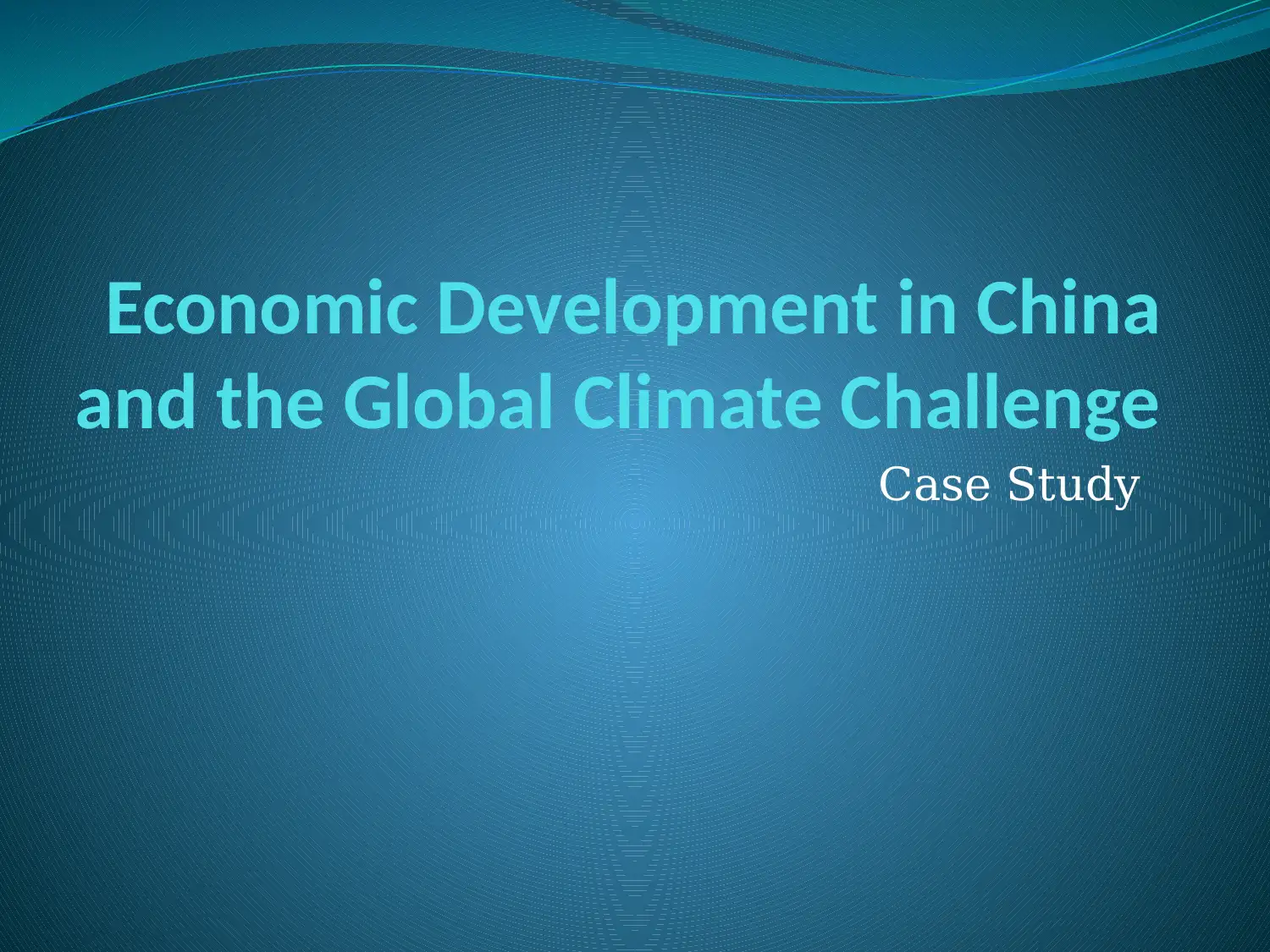
Economic Development in China
and the Global Climate Challenge
Case Study
and the Global Climate Challenge
Case Study
Paraphrase This Document
Need a fresh take? Get an instant paraphrase of this document with our AI Paraphraser
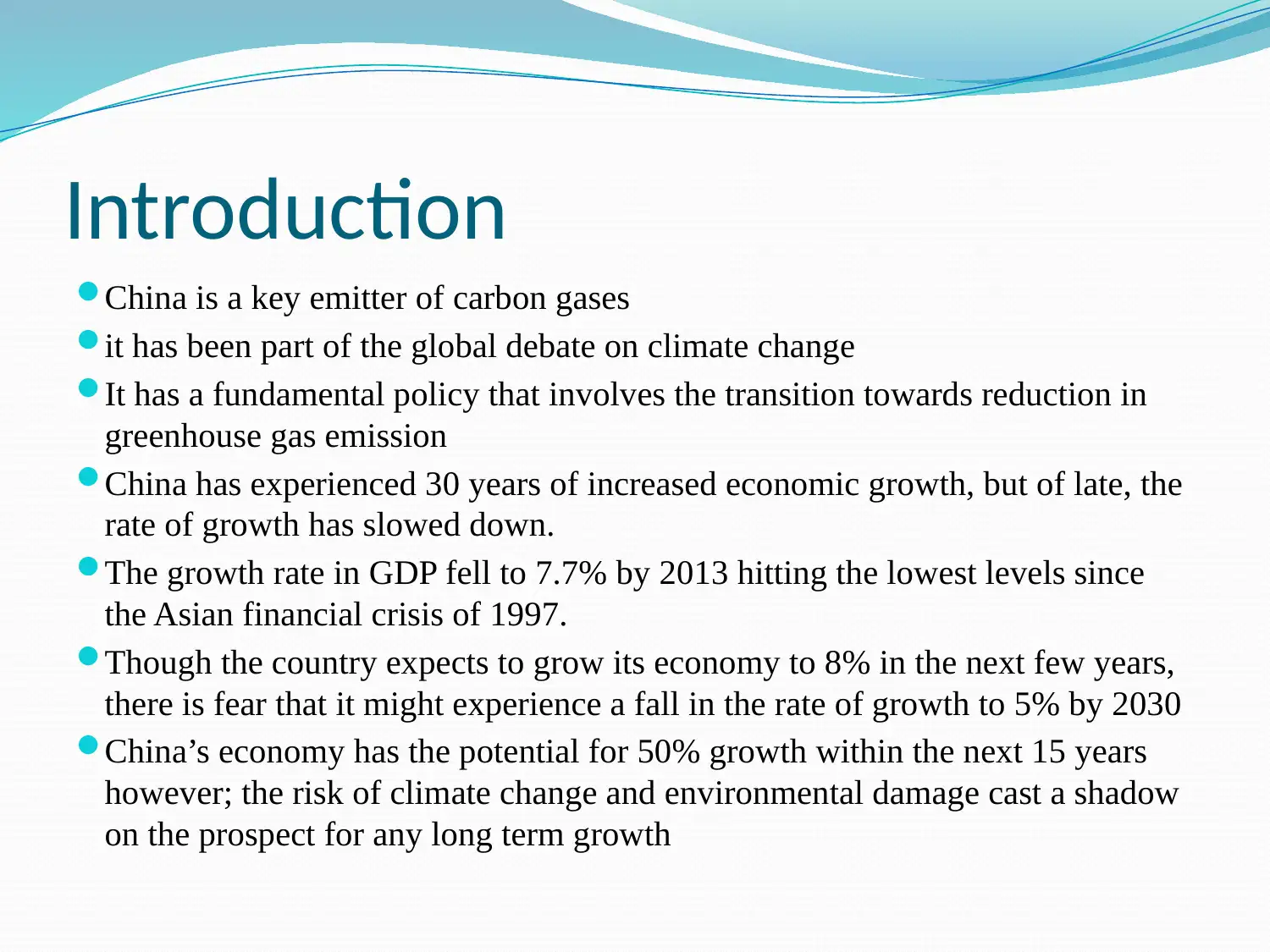
Introduction
China is a key emitter of carbon gases
it has been part of the global debate on climate change
It has a fundamental policy that involves the transition towards reduction in
greenhouse gas emission
China has experienced 30 years of increased economic growth, but of late, the
rate of growth has slowed down.
The growth rate in GDP fell to 7.7% by 2013 hitting the lowest levels since
the Asian financial crisis of 1997.
Though the country expects to grow its economy to 8% in the next few years,
there is fear that it might experience a fall in the rate of growth to 5% by 2030
China’s economy has the potential for 50% growth within the next 15 years
however; the risk of climate change and environmental damage cast a shadow
on the prospect for any long term growth
China is a key emitter of carbon gases
it has been part of the global debate on climate change
It has a fundamental policy that involves the transition towards reduction in
greenhouse gas emission
China has experienced 30 years of increased economic growth, but of late, the
rate of growth has slowed down.
The growth rate in GDP fell to 7.7% by 2013 hitting the lowest levels since
the Asian financial crisis of 1997.
Though the country expects to grow its economy to 8% in the next few years,
there is fear that it might experience a fall in the rate of growth to 5% by 2030
China’s economy has the potential for 50% growth within the next 15 years
however; the risk of climate change and environmental damage cast a shadow
on the prospect for any long term growth
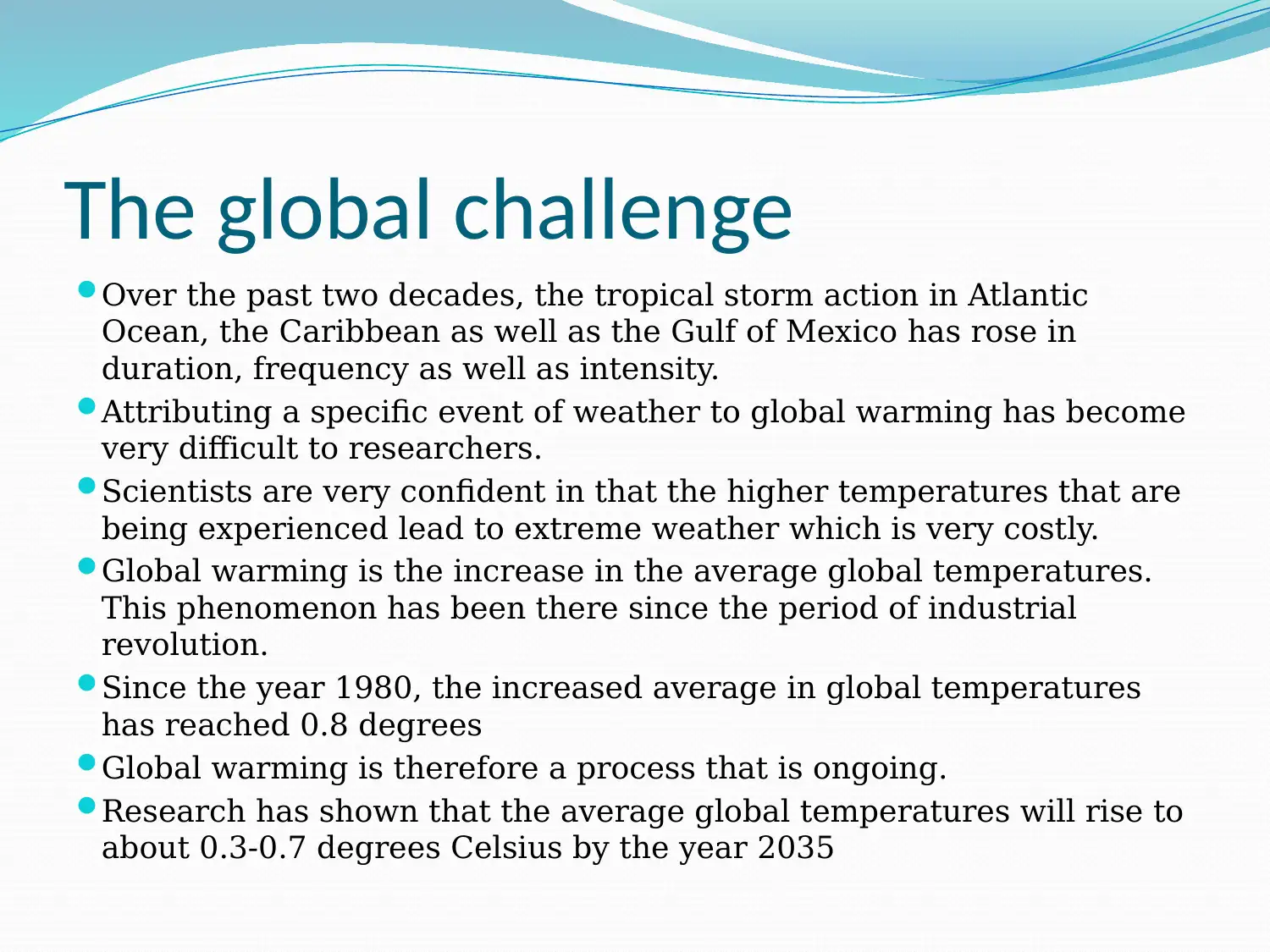
The global challenge
Over the past two decades, the tropical storm action in Atlantic
Ocean, the Caribbean as well as the Gulf of Mexico has rose in
duration, frequency as well as intensity.
Attributing a specific event of weather to global warming has become
very difficult to researchers.
Scientists are very confident in that the higher temperatures that are
being experienced lead to extreme weather which is very costly.
Global warming is the increase in the average global temperatures.
This phenomenon has been there since the period of industrial
revolution.
Since the year 1980, the increased average in global temperatures
has reached 0.8 degrees
Global warming is therefore a process that is ongoing.
Research has shown that the average global temperatures will rise to
about 0.3-0.7 degrees Celsius by the year 2035
Over the past two decades, the tropical storm action in Atlantic
Ocean, the Caribbean as well as the Gulf of Mexico has rose in
duration, frequency as well as intensity.
Attributing a specific event of weather to global warming has become
very difficult to researchers.
Scientists are very confident in that the higher temperatures that are
being experienced lead to extreme weather which is very costly.
Global warming is the increase in the average global temperatures.
This phenomenon has been there since the period of industrial
revolution.
Since the year 1980, the increased average in global temperatures
has reached 0.8 degrees
Global warming is therefore a process that is ongoing.
Research has shown that the average global temperatures will rise to
about 0.3-0.7 degrees Celsius by the year 2035
⊘ This is a preview!⊘
Do you want full access?
Subscribe today to unlock all pages.

Trusted by 1+ million students worldwide
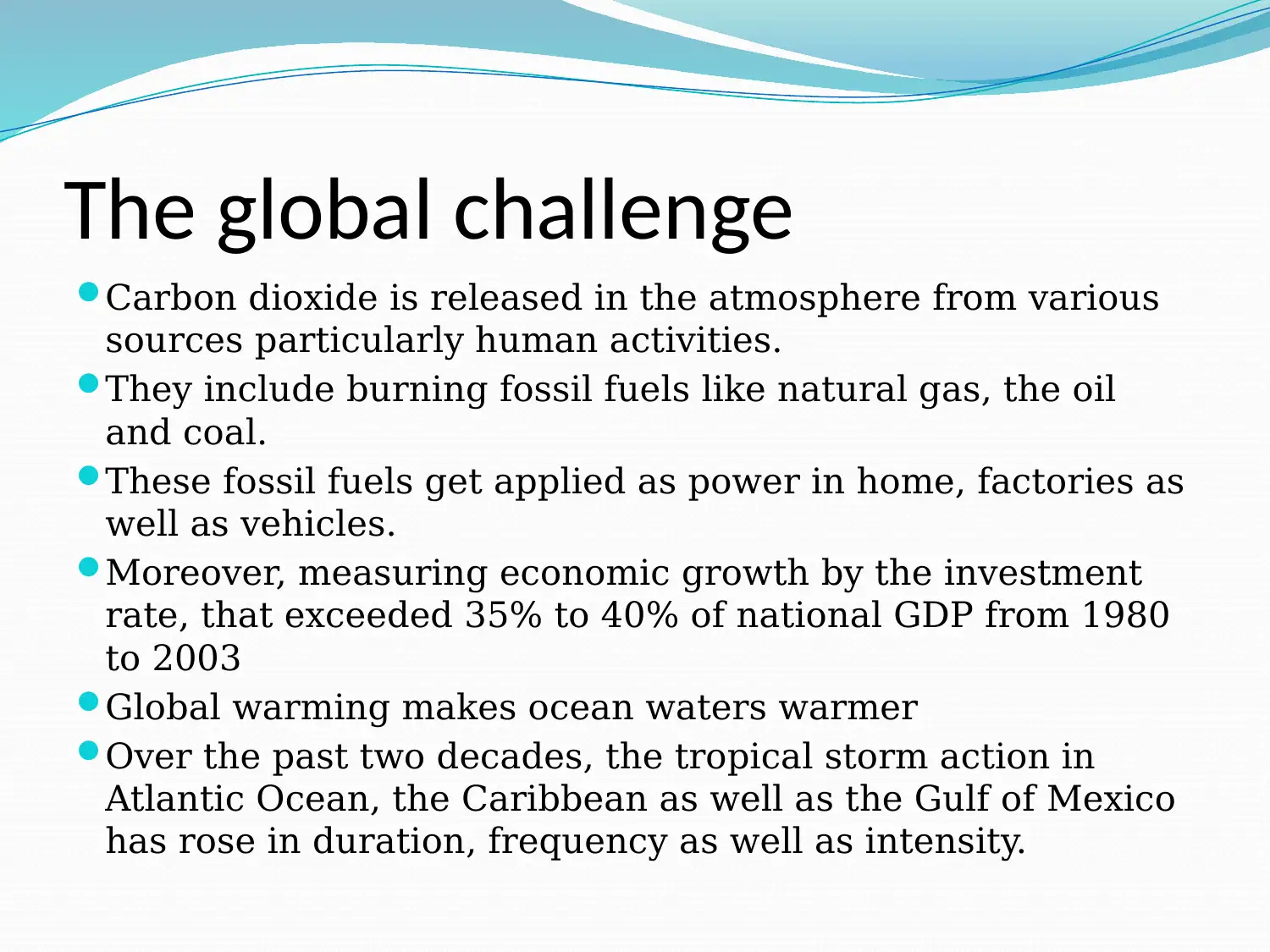
The global challenge
Carbon dioxide is released in the atmosphere from various
sources particularly human activities.
They include burning fossil fuels like natural gas, the oil
and coal.
These fossil fuels get applied as power in home, factories as
well as vehicles.
Moreover, measuring economic growth by the investment
rate, that exceeded 35% to 40% of national GDP from 1980
to 2003
Global warming makes ocean waters warmer
Over the past two decades, the tropical storm action in
Atlantic Ocean, the Caribbean as well as the Gulf of Mexico
has rose in duration, frequency as well as intensity.
Carbon dioxide is released in the atmosphere from various
sources particularly human activities.
They include burning fossil fuels like natural gas, the oil
and coal.
These fossil fuels get applied as power in home, factories as
well as vehicles.
Moreover, measuring economic growth by the investment
rate, that exceeded 35% to 40% of national GDP from 1980
to 2003
Global warming makes ocean waters warmer
Over the past two decades, the tropical storm action in
Atlantic Ocean, the Caribbean as well as the Gulf of Mexico
has rose in duration, frequency as well as intensity.
Paraphrase This Document
Need a fresh take? Get an instant paraphrase of this document with our AI Paraphraser

Introduction to Chinese case study
China has been noted to be among the world’s greatest emitters
of these gases on top of them being the major economies.
Various international agreements such as the Kyoto protocol of
1990 and the Paris agreement of 2015 have been formed to act
as a plea and call on the international states to join the treaty
and campaign against carbon emission and find a common
solution to the climate change issue.
China has been a member of these two treaties with its efforts
to join the international fight against climate change since 1990
Kyoto 1 achieved very high levels of conformity when the Annex
B nations met their targets of mitigating the emissions during
the first five-year interval.
The objectives of the protocol are expected to be met in 2020.
China has been noted to be among the world’s greatest emitters
of these gases on top of them being the major economies.
Various international agreements such as the Kyoto protocol of
1990 and the Paris agreement of 2015 have been formed to act
as a plea and call on the international states to join the treaty
and campaign against carbon emission and find a common
solution to the climate change issue.
China has been a member of these two treaties with its efforts
to join the international fight against climate change since 1990
Kyoto 1 achieved very high levels of conformity when the Annex
B nations met their targets of mitigating the emissions during
the first five-year interval.
The objectives of the protocol are expected to be met in 2020.
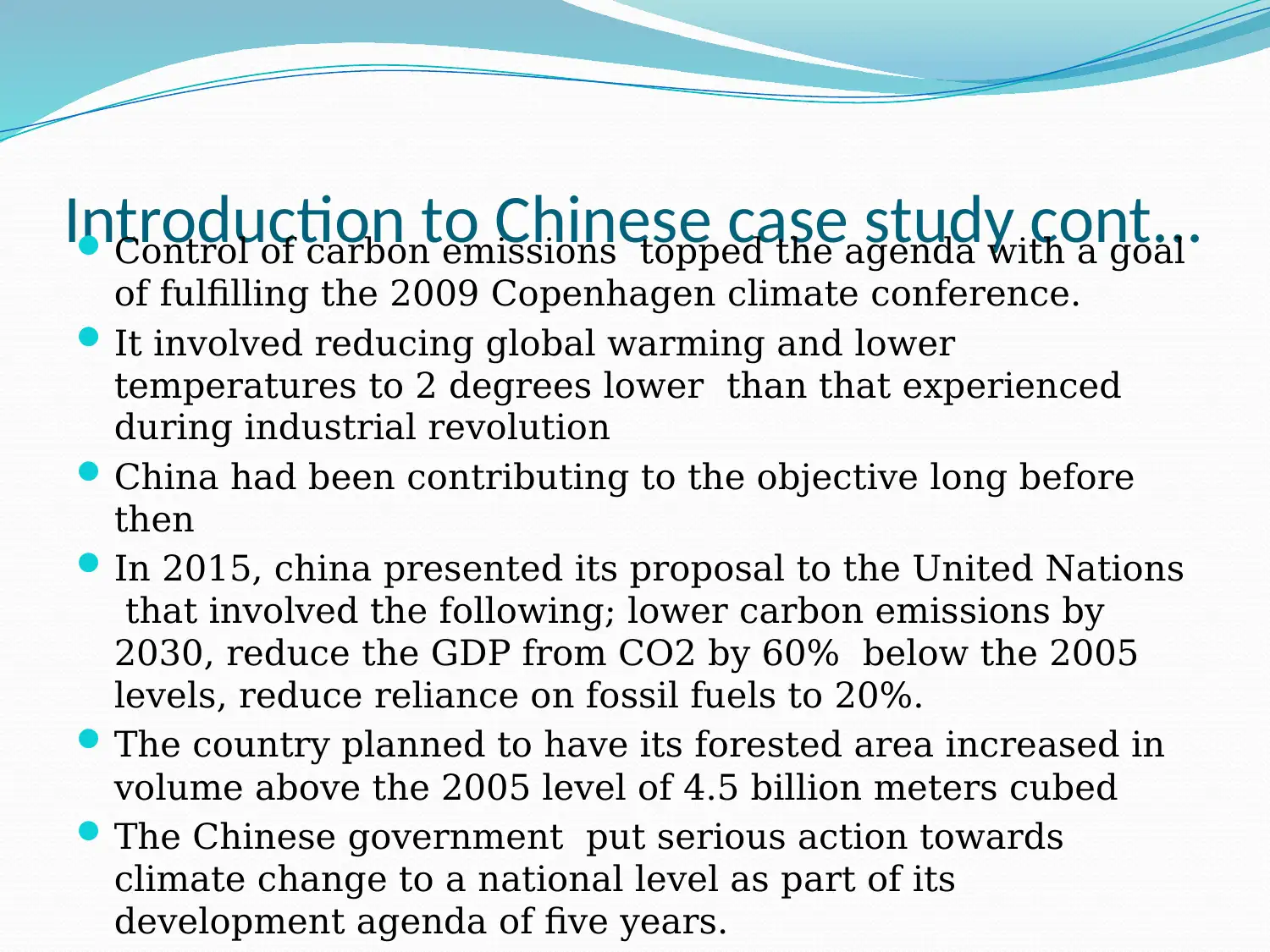
Introduction to Chinese case study cont... Control of carbon emissions topped the agenda with a goal
of fulfilling the 2009 Copenhagen climate conference.
It involved reducing global warming and lower
temperatures to 2 degrees lower than that experienced
during industrial revolution
China had been contributing to the objective long before
then
In 2015, china presented its proposal to the United Nations
that involved the following; lower carbon emissions by
2030, reduce the GDP from CO2 by 60% below the 2005
levels, reduce reliance on fossil fuels to 20%.
The country planned to have its forested area increased in
volume above the 2005 level of 4.5 billion meters cubed
The Chinese government put serious action towards
climate change to a national level as part of its
development agenda of five years.
of fulfilling the 2009 Copenhagen climate conference.
It involved reducing global warming and lower
temperatures to 2 degrees lower than that experienced
during industrial revolution
China had been contributing to the objective long before
then
In 2015, china presented its proposal to the United Nations
that involved the following; lower carbon emissions by
2030, reduce the GDP from CO2 by 60% below the 2005
levels, reduce reliance on fossil fuels to 20%.
The country planned to have its forested area increased in
volume above the 2005 level of 4.5 billion meters cubed
The Chinese government put serious action towards
climate change to a national level as part of its
development agenda of five years.
⊘ This is a preview!⊘
Do you want full access?
Subscribe today to unlock all pages.

Trusted by 1+ million students worldwide

The key transition
Air pollution in China is quite severe and is becoming a constraint to
the country’s social and economic development.
The significant characteristic involves high concentration of (PM)
particulate matter that leads to increased smog in most regions.
The Pearl river delta, the Yangtze river delta and the Jing-Jin-Ji region
are the most polluted regions.
Coal burning is responsible for PM 2.5 in these areas with
productions reaching between 50% and 70%.
China has so far tried to apply emission reduction and energy
conservation measures in the named regions.
Other methods include the end-of-pipe measures of treatment in
tackling the problem of air pollution.
Air pollution in China is quite severe and is becoming a constraint to
the country’s social and economic development.
The significant characteristic involves high concentration of (PM)
particulate matter that leads to increased smog in most regions.
The Pearl river delta, the Yangtze river delta and the Jing-Jin-Ji region
are the most polluted regions.
Coal burning is responsible for PM 2.5 in these areas with
productions reaching between 50% and 70%.
China has so far tried to apply emission reduction and energy
conservation measures in the named regions.
Other methods include the end-of-pipe measures of treatment in
tackling the problem of air pollution.
Paraphrase This Document
Need a fresh take? Get an instant paraphrase of this document with our AI Paraphraser

The transition in broad perspective
China has been undergoing industrialization process as its
key effort of urbanization.
The country’s rapid growth in economy makes it overly
dependent on the use of fossil fuels
The country has a working energy conservation policy
that seeks to reduce emissions regardless of the country
depending on coal for industrial production.
China has been undergoing industrialization process as its
key effort of urbanization.
The country’s rapid growth in economy makes it overly
dependent on the use of fossil fuels
The country has a working energy conservation policy
that seeks to reduce emissions regardless of the country
depending on coal for industrial production.
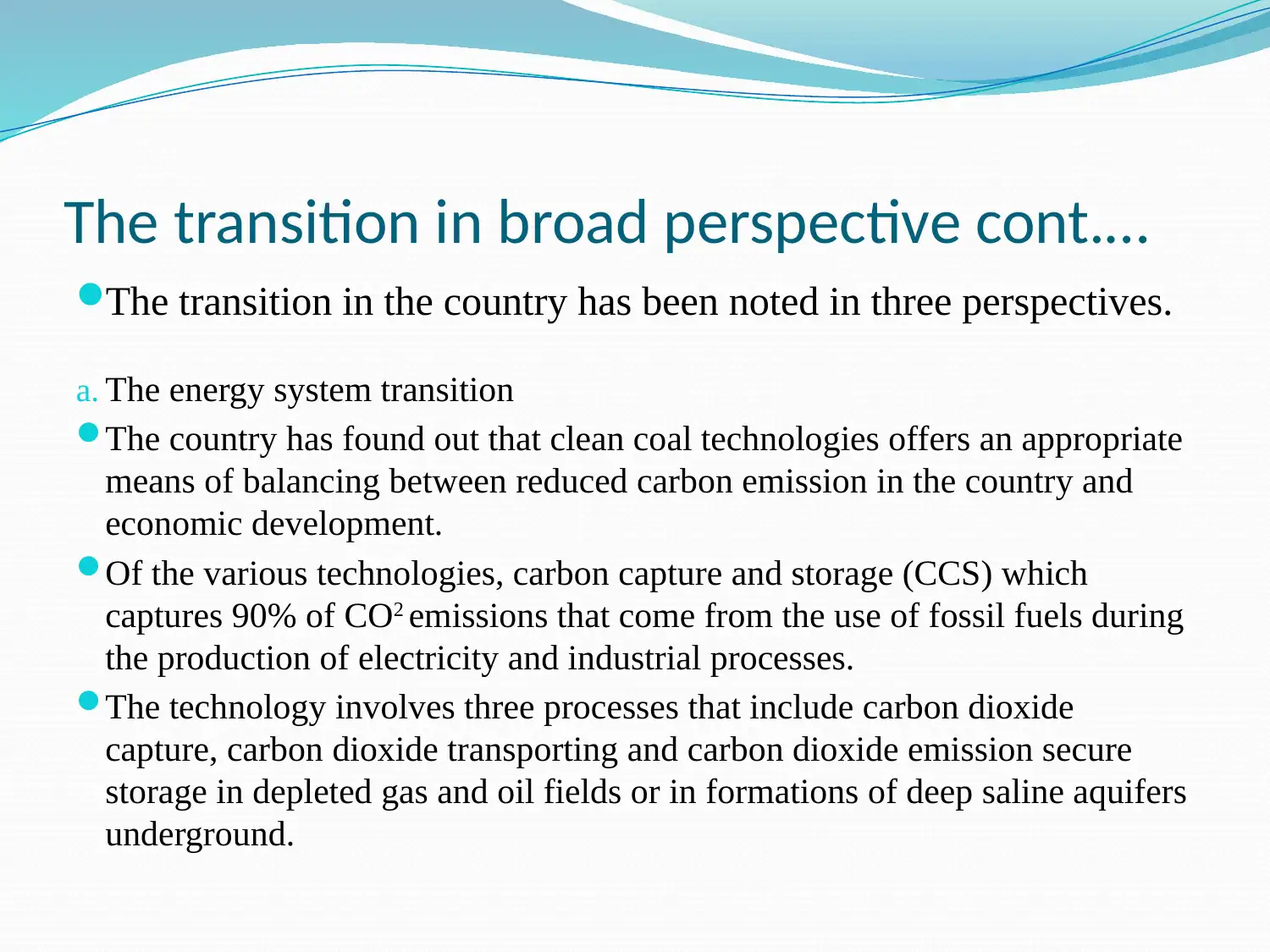
The transition in broad perspective cont.…
The transition in the country has been noted in three perspectives.
a. The energy system transition
The country has found out that clean coal technologies offers an appropriate
means of balancing between reduced carbon emission in the country and
economic development.
Of the various technologies, carbon capture and storage (CCS) which
captures 90% of CO2 emissions that come from the use of fossil fuels during
the production of electricity and industrial processes.
The technology involves three processes that include carbon dioxide
capture, carbon dioxide transporting and carbon dioxide emission secure
storage in depleted gas and oil fields or in formations of deep saline aquifers
underground.
The transition in the country has been noted in three perspectives.
a. The energy system transition
The country has found out that clean coal technologies offers an appropriate
means of balancing between reduced carbon emission in the country and
economic development.
Of the various technologies, carbon capture and storage (CCS) which
captures 90% of CO2 emissions that come from the use of fossil fuels during
the production of electricity and industrial processes.
The technology involves three processes that include carbon dioxide
capture, carbon dioxide transporting and carbon dioxide emission secure
storage in depleted gas and oil fields or in formations of deep saline aquifers
underground.
⊘ This is a preview!⊘
Do you want full access?
Subscribe today to unlock all pages.

Trusted by 1+ million students worldwide
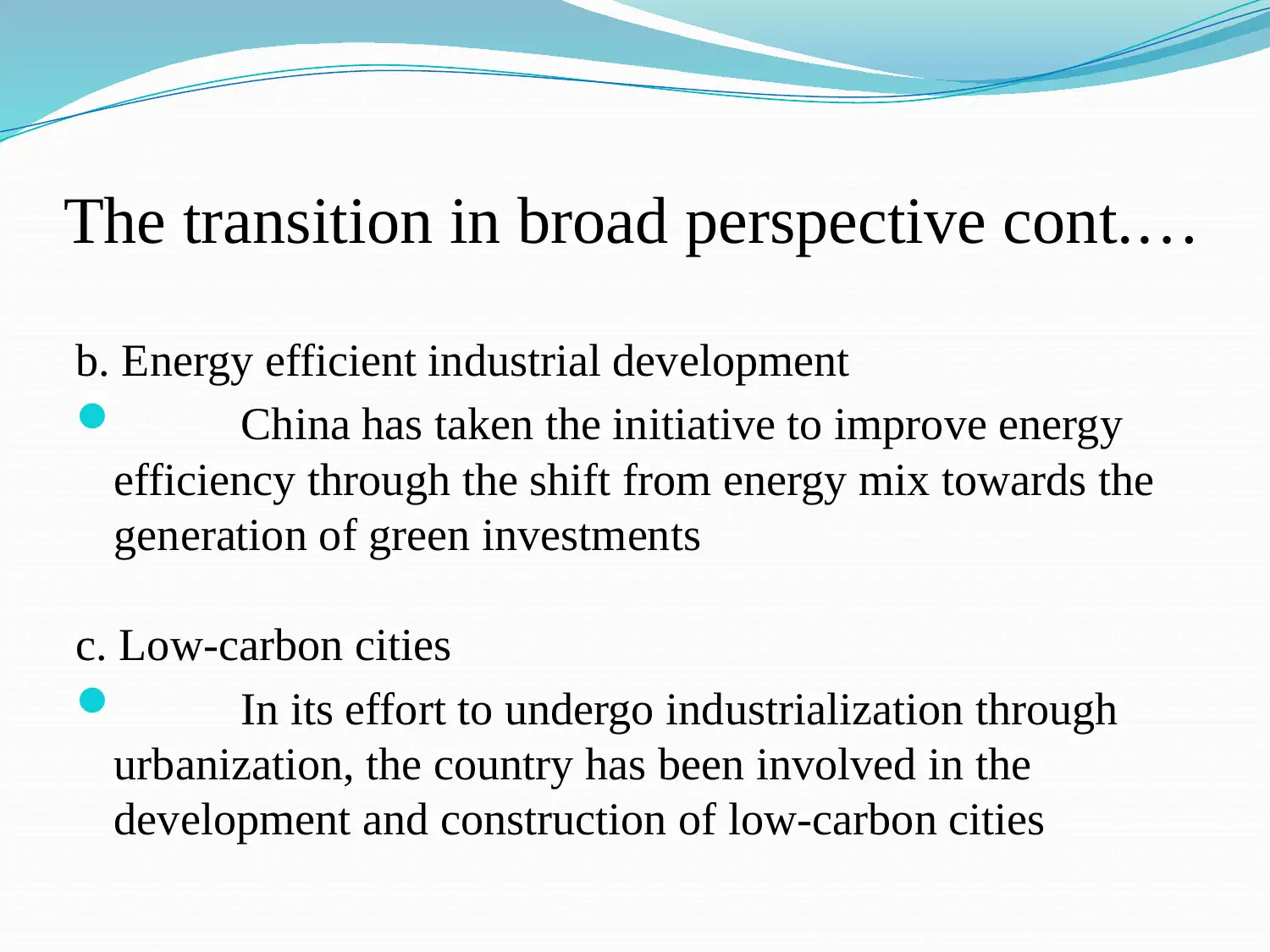
The transition in broad perspective cont.…
b. Energy efficient industrial development
China has taken the initiative to improve energy
efficiency through the shift from energy mix towards the
generation of green investments
c. Low-carbon cities
In its effort to undergo industrialization through
urbanization, the country has been involved in the
development and construction of low-carbon cities
b. Energy efficient industrial development
China has taken the initiative to improve energy
efficiency through the shift from energy mix towards the
generation of green investments
c. Low-carbon cities
In its effort to undergo industrialization through
urbanization, the country has been involved in the
development and construction of low-carbon cities
Paraphrase This Document
Need a fresh take? Get an instant paraphrase of this document with our AI Paraphraser
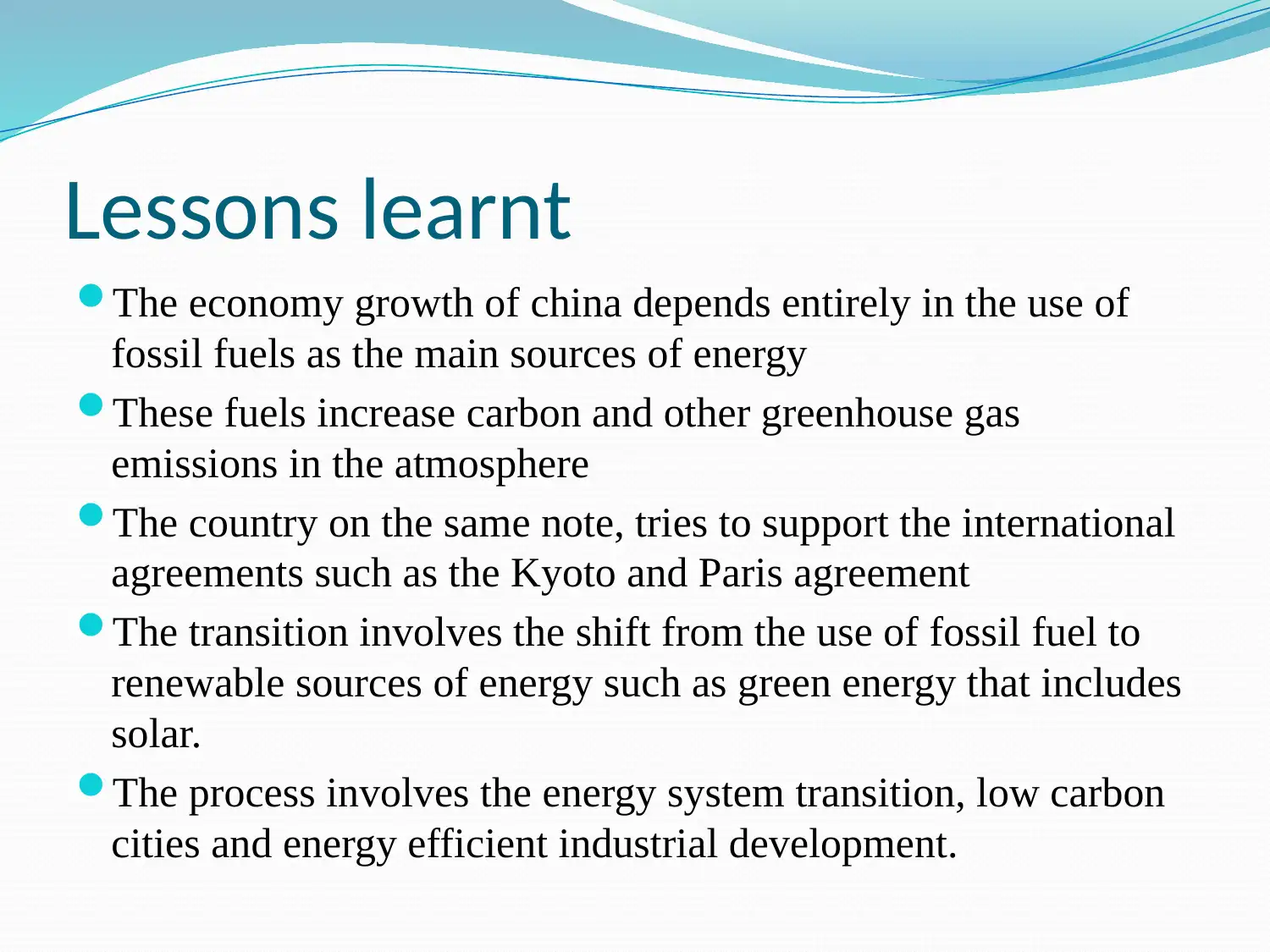
Lessons learnt
The economy growth of china depends entirely in the use of
fossil fuels as the main sources of energy
These fuels increase carbon and other greenhouse gas
emissions in the atmosphere
The country on the same note, tries to support the international
agreements such as the Kyoto and Paris agreement
The transition involves the shift from the use of fossil fuel to
renewable sources of energy such as green energy that includes
solar.
The process involves the energy system transition, low carbon
cities and energy efficient industrial development.
The economy growth of china depends entirely in the use of
fossil fuels as the main sources of energy
These fuels increase carbon and other greenhouse gas
emissions in the atmosphere
The country on the same note, tries to support the international
agreements such as the Kyoto and Paris agreement
The transition involves the shift from the use of fossil fuel to
renewable sources of energy such as green energy that includes
solar.
The process involves the energy system transition, low carbon
cities and energy efficient industrial development.
1 out of 11
Related Documents
Your All-in-One AI-Powered Toolkit for Academic Success.
+13062052269
info@desklib.com
Available 24*7 on WhatsApp / Email
![[object Object]](/_next/static/media/star-bottom.7253800d.svg)
Unlock your academic potential
© 2024 | Zucol Services PVT LTD | All rights reserved.




